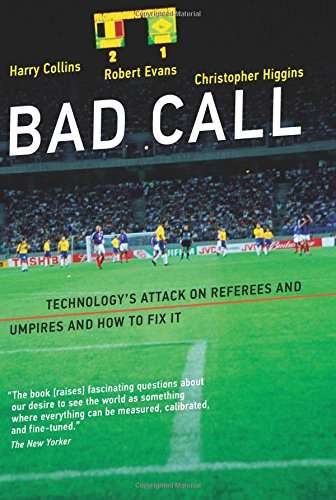Sophisticated data analysis is creeping into more human endeavors — and even into professional sports. But as data technicians struggle to convert human movements into measurements for binary decision trees, some bar stool philosophers are already asking whether there are areas where technology shouldn’t go.
One of those areas is a refereeing sports.
Several sports are already at least partly officiated by technology, according to an article on the Hewlett Packard Enterprise blog. Since 2006 professional tennis tournaments have been piping high-definition video through an AI system that dispenses binding judgments on whether a ball was in or out. “This technology doesn’t assist the referee. It is the referee.” It’s accurate to within 3.6 millimeters (less than a quarter inch).
Yet humans still make other rulings in tennis — for example, whether shouting at your opponent crosses the line into interference — and every sport has its share of moments where a human official must judge a player’s intent. “Was that collision of hockey players a check or a foul? When the basketball player blocked the shot, did she extend her arms too far? Did the soccer player intend to trip his opponent, or was he going for the ball and took him down by accident?”
 A recent book, “Bad Call: Technology’s Attack on Referees and Umpires and How to Fix It,” explores how technology is now working its way into our other sports — even as its three authors remain skeptical. They’re okay with the “track estimators” used in cricket matches (which predict the route a ball would have taken had it not been hit). But some people have also proposed “goal-line technology” for soccer, monitoring whether a ball has fully entered the goal. The book’s introduction argues this would have a minimal impact on game outcomes — and it wouldn’t even begin to address the 100+ bad penalty calls each season. It suggests there’s a much easier way to improve the game: just let the human referees review video replays.
A recent book, “Bad Call: Technology’s Attack on Referees and Umpires and How to Fix It,” explores how technology is now working its way into our other sports — even as its three authors remain skeptical. They’re okay with the “track estimators” used in cricket matches (which predict the route a ball would have taken had it not been hit). But some people have also proposed “goal-line technology” for soccer, monitoring whether a ball has fully entered the goal. The book’s introduction argues this would have a minimal impact on game outcomes — and it wouldn’t even begin to address the 100+ bad penalty calls each season. It suggests there’s a much easier way to improve the game: just let the human referees review video replays.
Yet some geeks still look to a day when all sports officiating is automated.
Humans Weigh in
But equally intriguing are the arguments from those humans who disagree. “Sports is a human activity,” says Harry Collins, a 72-year-old professor of social sciences at Cardiff University in Wales who co-authored the book Bad Call. He shares his own personal philosophy with the Hewlett Packard Enterprise blog. “Humans are imperfect; that’s OK. Everyone knows that sometimes referees are going to make a mistake. It’s worked that way for hundreds of years.”
In the book’s introduction, Collins remembers watching a soccer game with his children where Liverpool beat Manchester City — and won the coveted Premier League title — thanks to penalties that weren’t called. “Are we saddened by the fact that we won by foul means? No — we’re whooping! First, because football fans like to win however it is done. But more importantly, because this balances out what happened earlier in the season… What we saw on this occasion was the play of chance giving us justice….”
“As they say, ‘It all balances out in the end.’”
I’ve been hacking on a notebook using @observablehq and @d3js_org to visualize a @TensorFlow.js deep-neural network during training. This demo trains a model to call a virtual strike zone based on MLBAM PITCHf/x data:https://t.co/RdkF9WqXtu
** Not supported on mobile devices pic.twitter.com/0Ip2JJCVdG
— nkreeger (@nkreeger) June 9, 2018
And what happens when the machines come for the all-American sport of baseball? Robot umpires behind home plate are now a real possibility, according to the commissioner of Major League Baseball (MLB), Rob Manfred. “I think we are much closer than we were a year ago to having the technological capability to actually call the strike zone…” he told the Atlantic’s sports blog in May. “The accuracy is way up — way better than what it was a year ago. The technology continues to move… and it actually moved a little faster than I might have thought.”
At the Associated Press Sports Editors meeting in 2017 Manfred acknowledged that it’s only a matter of time. “Sooner or later, we are going to have technology that will be accurate and fast enough to call a computerized strike zone.”
Though even in 2017, he was adding a warning. “[A]t that point that you have to ask yourself a question as to whether you want to take that human element out of the game and replace it with a machine.”
In 2006 every MLB stadium was equipped with a camera-based system called PITCHf/x to watch pitches — not just to calculate whether they were balls and strikes (accurate within half an inch), but also watching their speed and direction. The information was displayed in real-time at the MLB site, in the “GameDay” webcasts of play-by-play game information. But the information wasn’t provided to the officials; only to the fans.
So fans could now yell at the umpires while backing up their disagreements with data.
“Someday soon you’ll be able to say that certain umpires do indeed suck,” quipped Slate. “And which umpires suck more than others. And if, generally, they suck less if they’re taller.”
PITCHfx and HITfx are being installed at Driveline Baseball as we speak. There’s one for the nerds. Boom. pic.twitter.com/TTitxTCpVm
— Kyle Boddy (@drivelinebases) June 20, 2017
But can we trust our machines? Last year MLB phased in a newer system called Statcast — which performed the same feat using both cameras and radar. “On paper, Statcast is an incredible leap forward,” wrote the baseball columnist at FiveThirtyEight, adding at the time that “when it works, it’s amazing. But so far, it has struggled to measure the basic elements of pitching that PITCHf/x had down cold…”
They spoke to Kyle Boddy, the founder of a data-driven player development program called Driveline Baseball, who remembers how Major League Baseball had fine-tuned PITCHf/x using collaboration. “The data was open sourced and required tons of work from the public sphere to massage and get right.” Blogger Dave Cameron once even used data from Gameday to identify why Seattle Mariners pitcher Felix Hernandez was giving up so many runs early in the game. Hernandez was apparently throwing too many fastballs at the start of the game, according to an article on Slate about Cameron’s legendary blog post. “The coach printed out the post and handed it to Hernandez. Next time out, the pitcher laid off the fastball and threw eight innings of shutout ball.”
Last year found FiveThirtyEight complaining that with the new system, MLB “is now providing very little detail about Statcast’s internal workings.”
As the years rolled along, human baseball officials have made another concession. In 2014 a new rule was added to MLB games allowing managers to challenge a limited number of plays per game, after which it would be reviewed from all the available camera angles. If nothing else, this can spare the umpires from the pain of making a truly bad call.
It’s not a hypothetical scenario. In 2010 umpire Jim Joyce tearfully apologized for mistakenly ruling in the 9th inning that a runner was safe at first — thus robbing 28-year-old pitcher Armando Galarraga of the precious final out that would’ve otherwise given him the 21st “perfect game” in the history of major league baseball. The young pitcher had run to first to make the final out, but the umpire ruled that the runner was safe — recognizing his mistake later when he watches a video replay.
But in one of the most truly human moments in sports, pitcher Galarraga graciously forgave umpire Joyce, saying that the poor umpire “probably feels more bad than me. Nobody’s perfect. Everybody’s human. I understand.” Galarraga and Joyce even teamed up to write a 257-page book.

And it’s the human memories of Galarraga that really put this story into perspective. Galarraga reveals that he’d honestly thought that the umpire had been making a joke. “I know with my own eyes what I have just seen. And it is not only with my eyes. I know by listening. I know when my foot touches the base. I know when the batter touches the base. I can feel these things because I am a part of them…”
The call of the umpire vanishes when confronted with something even greater: Galarraga’s joy of playing the game. “I am too happy with how I am pitching and how I have reached all the way to the end of the game without allowing one of the Cleveland batters to get on base. It is such a joyful moment that nothing can make me sad. It is a perfect, perfect game, and I realize that nothing can change the truth of this perfect, perfect game. I tell this to people later and they do not believe me… I know in my heart that I have now completed my perfect game. The moment my foot touches first base, I know this.
“It is something to share with my father. It is something to tell my children and my grandchildren. It is something that the people of Venezuela will always remember.”
Galarraga concedes it’s hard to focus on the next batter. “I am thinking that I have many blessings, so many reasons to smile. I am too happy, so I cannot be too sad…
“I am thinking, Armando, if you keep pitching like this there will be many more chances for a perfect game….”
WebReduce
- IBM’s newest AI project: a robot debater.
- Are we getting closer to AI doctors?
- How a machine learning company used cloud-based parallel processing to crack the “unbreakable” Enigma code.
- A 90-year-old man remembers working on the world’s first stored-program computer back in 1948.
- Portland launches its “Smart City” initiative with sensors collecting traffic data.
- Calfornia now offers Kindle-style “e-paper” license plates.
- Humans react to the news: a man was fired by a machine.
- Game developers release a new video for the Amiga.
- Stephen Wolfram’s Mathematica celebrates its 30th birthday.
- Remembering Kazuo Kashio, the founder of Casio computers.
Feature image via Wikipedia, CC BY- SA 3.0.


















